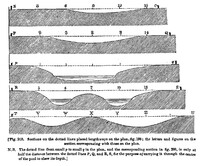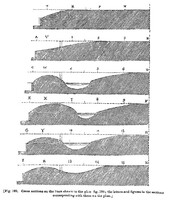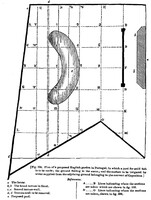Thirdly. There is another circumstance belonging to English gardens, which may possibly be imitated in any climate; and that relates to the prevailing lines of walks, &c. In the old gardens of France and Italy, and I suppose it is the same in Portugal, the walks are always straight, the surface generally flat; and all the shapes, whether of land, of water, of beds, or of parterres and borders, are drawn in circles, or squares, by straight mathematical rules. These are evidently works of art, and do not pretend to any resemblance to nature: indeed, when the ground has been formed into level terraces, supported by straight walls, perhaps a straight walk, parallel to the wall, is more rational than the affectation of a serpentine walk, which can only be justified either by irregularity of surface, or by the variety of views. In a straight walk, the view forward is always the same; but, in a curving walk, it varies with every step we take: thus, whether it consist of distant prospects, or of the shrubs and plants near the eye, the scene is constantly changing, and this characteristic of an English garden may be imitated in any country. The annexed plan will fully explain how this may be accomplished in the present instance; but there is also an expedient suggested to realize the English style in two other circumstances, viz. the inequality of surface, and its verdure. I am given to understand, that the broad terrace, or platform, near the house, is about six or eight feet above the second terrace, and that water may be brought thither to supply a basin for gold and silver fish; let us, therefore, suppose the shape of the ground to be altered according to the annexed plan and sections:* this will make a fall in every direction towards the pool; and if the water, by which this pool is to be supplied, be led along a narrow channel of stone, or lead, from every part of which it may trickle on the grass, it may be spread over the whole surface, in the same manner as water meadows are irrigated, and in the hottest climate the verdure will be preserved; especially, if some trees be planted round the area, to contribute their shade. By this expedient, I have no doubt, we may produce a specimen of English verdure in the upper ground; and, if it succeeds there, it may also be made to succeed equally in the lowest ground, by the water in the well in the middle of the garden. Not having seen the spot, and not knowing what plants or shrubs there may be now growing, or what will best succeed in this situation, I shall give the following general rules for the planting, after the ground is shaped according to the preceding diagrams. *[In describing this garden of Portugal, the plan for the walks and shrubberies has been omitted; but the map [fig. 198], inserted with the sections of the ground [figs. 199 and 200], may be considered as of a more general nature; serving to explain the process of laying out a surface in such manner, that it may be raised and sunk, according to the stakes by which the ground is divided into squares. This was done, under my direction, at the gardens at the Pavillon at Brighton, and the whole surface altered accordingly.]





